PhysX Performance Update: City of Villains
by Ryan Smith on September 7, 2006 6:00 AM EST- Posted in
- GPUs
PhysX Performance
As we mentioned previously, even with demo recording, City of Villains does not recreate the exact same scenario every time (similar to Oblivion), so any benchmarks under CoV will still have a higher variance than normal. In order to get a better approximation of performance, every benchmark has been run multiple times, but a 1-2 FPS difference is still within the normal variance. As we noted in our previous article, CoV is a CPU-limited application, so we'll stick with the highest resolution.
For these tests, we have run them both with only a single and both cores of our Core 2 Duo X6800 in order to illustrate the impact of the second core.
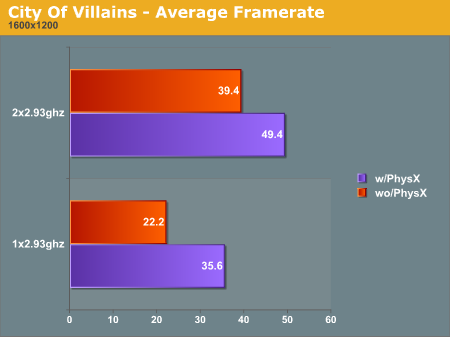
With the changes offered by Cryptic, the tables have turned significantly on the performance results. Now that we can use the same physics quality with both software and hardware rendering, it's easy to see just how loaded down the processor is when trying to perform the exact same physics calculations the PhysX card is. For our dual-core X6800 at full speed, using the PhysX card offers an average framerate about 25% higher than without, and on our X6800 running with just one active core, that jumps up to a 60% difference.
It's interesting to note the impact of the second core in relation to the PhysX card. While the card clearly offers a performance boost in all situations, the disparity between the boost of a dual-core system and a single-core is rather remarkable. Against a single-core system, the PhysX card is increasing performance by about 60%, but adding a second core instead of a PhysX card adds an even larger 77%. Granted, our single-core setup is slightly contrived, as Intel won't be selling a single-core Core architecture CPUs at this speed grade, but there are numerous systems out there currently running single-core processors where a dual-core processor could simply be dropped in.
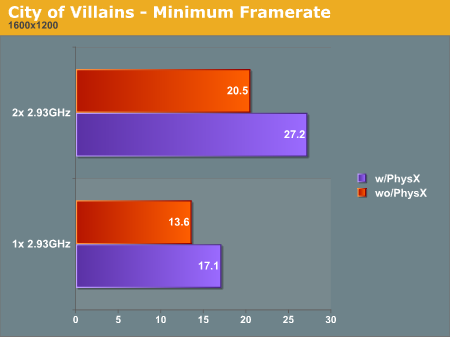
Switching to taking a look at the minimum framerate, the results are nearly identical. The physics calculations being done for CoV have a large impact on performance resulting in the PhysX card boosting performance by 35% on the dual-core setup. However, the overhead from other parts of the engine start to catch up to the single-core setup, where the performance boost is only 25%. Again, relative to the single-core configuration running software PhysX algorithms, adding the second core offers a larger boost than adding a PhysX card. The dual-core software PhysX calculations are 11% faster in average frame rates and 20% faster in minimum frame rates than a single-core processor with hardware PhysX.
Given the performance boost offered by the second core, we thought that perhaps the PhysX card could be more competitive on a dual-core system with a slower clock speed. We downclocked our X6800 to 1.86ghz to find out.
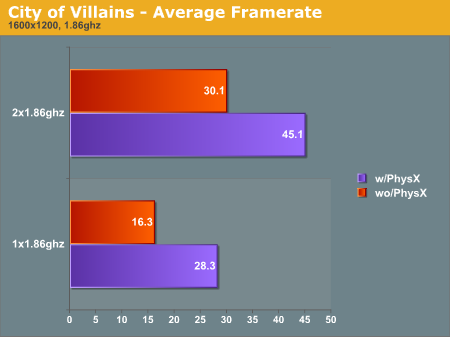
Since reducing the clockspeed of our CPU doesn't directly reduce the performance of the PhysX card, we find that our earlier theory is correct and that the PhysX card adds a hearty 50% with two cores functioning, and 73% with one core. Both results are greater than what we saw with a 2.93 GHz CPU. However, adding the second core also has a larger effect, this time at about 85% faster than a single core, although the dual-core setup is now only 6% faster than a single core with hardware PhysX.
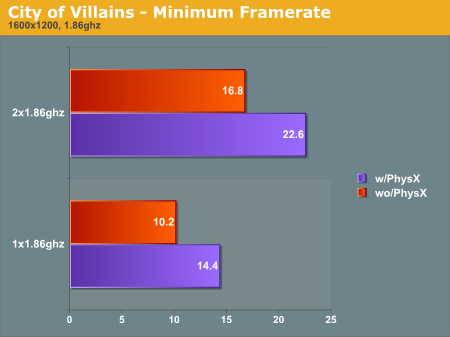
Returning to the minimum framerates, the numbers are somewhat similar to our earlier minimums, with a boost of 35% against a dual-core setup and 41% against the single-core, indicating that the speedup offered by the PhysX card is somewhat greater even with the additional overhead encountered by the slower single-core setup. Adding the second core without the PhysX card comes in at a 57% performance increase relative to a single core, which is 17% faster than the single core with a PhysX card.
Last but not least, how about the performance when the CPU is allowed to cheat a bit and use approximate physics calculations? As we mentioned before, only the highest physics mode pushes software and hardware to the same level of precision. The next-highest mode allows the software to run faster by using estimations rather than doing the full calculations, as well as generating a lower amount of debris.
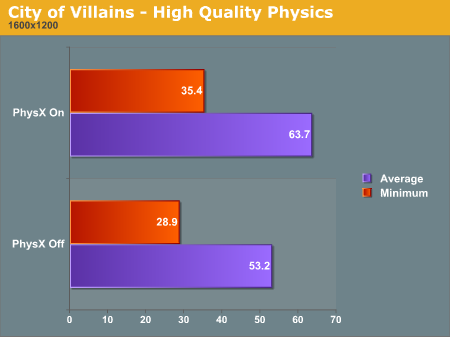
Even given the chance to cheat some, we still can't match the performance of using a PhysX card with a dual-core processor. The spread does drop to only 20%, but the setup using the PhysX card clearly takes the lead. It is worth noting however that the quality between these two modes is extremely close, even with the CPU using only physics approximations.
The highest quality mode still offers a superior amount of "stuff", and in turn the PhysX card does a better job of running that mode. The two modes are not easy to tell apart, though, and even less so in the middle of combat where such minor differences can easily be missed. If you compare the high-quality software PhysX scores on the dual core processor to the maximum quality hardware PhysX scores on the same setup, high-quality software PhysX ends up being slightly faster. Dropping the physics quality down a notch instead of buying a PhysX card is a perfectly viable alternative if extra performance is desired without spending any more money.
These numbers also show that even with our Core 2 Extreme processor, CoV is CPU limited both with and without the PhysX card. (You can also see this by referring back to the resolution scaling with ATI and NVIDIA cards on the previous page, for the 7900 GTX performance remains flat despite increasing resolutions.) What this means is that in these situations, the PhysX card is only useful up to the point where it's offloaded all the physics processing it can. Past that the bottleneck remains the CPU.
As we mentioned previously, even with demo recording, City of Villains does not recreate the exact same scenario every time (similar to Oblivion), so any benchmarks under CoV will still have a higher variance than normal. In order to get a better approximation of performance, every benchmark has been run multiple times, but a 1-2 FPS difference is still within the normal variance. As we noted in our previous article, CoV is a CPU-limited application, so we'll stick with the highest resolution.
For these tests, we have run them both with only a single and both cores of our Core 2 Duo X6800 in order to illustrate the impact of the second core.

With the changes offered by Cryptic, the tables have turned significantly on the performance results. Now that we can use the same physics quality with both software and hardware rendering, it's easy to see just how loaded down the processor is when trying to perform the exact same physics calculations the PhysX card is. For our dual-core X6800 at full speed, using the PhysX card offers an average framerate about 25% higher than without, and on our X6800 running with just one active core, that jumps up to a 60% difference.
It's interesting to note the impact of the second core in relation to the PhysX card. While the card clearly offers a performance boost in all situations, the disparity between the boost of a dual-core system and a single-core is rather remarkable. Against a single-core system, the PhysX card is increasing performance by about 60%, but adding a second core instead of a PhysX card adds an even larger 77%. Granted, our single-core setup is slightly contrived, as Intel won't be selling a single-core Core architecture CPUs at this speed grade, but there are numerous systems out there currently running single-core processors where a dual-core processor could simply be dropped in.

Switching to taking a look at the minimum framerate, the results are nearly identical. The physics calculations being done for CoV have a large impact on performance resulting in the PhysX card boosting performance by 35% on the dual-core setup. However, the overhead from other parts of the engine start to catch up to the single-core setup, where the performance boost is only 25%. Again, relative to the single-core configuration running software PhysX algorithms, adding the second core offers a larger boost than adding a PhysX card. The dual-core software PhysX calculations are 11% faster in average frame rates and 20% faster in minimum frame rates than a single-core processor with hardware PhysX.
Given the performance boost offered by the second core, we thought that perhaps the PhysX card could be more competitive on a dual-core system with a slower clock speed. We downclocked our X6800 to 1.86ghz to find out.

Since reducing the clockspeed of our CPU doesn't directly reduce the performance of the PhysX card, we find that our earlier theory is correct and that the PhysX card adds a hearty 50% with two cores functioning, and 73% with one core. Both results are greater than what we saw with a 2.93 GHz CPU. However, adding the second core also has a larger effect, this time at about 85% faster than a single core, although the dual-core setup is now only 6% faster than a single core with hardware PhysX.

Returning to the minimum framerates, the numbers are somewhat similar to our earlier minimums, with a boost of 35% against a dual-core setup and 41% against the single-core, indicating that the speedup offered by the PhysX card is somewhat greater even with the additional overhead encountered by the slower single-core setup. Adding the second core without the PhysX card comes in at a 57% performance increase relative to a single core, which is 17% faster than the single core with a PhysX card.
Last but not least, how about the performance when the CPU is allowed to cheat a bit and use approximate physics calculations? As we mentioned before, only the highest physics mode pushes software and hardware to the same level of precision. The next-highest mode allows the software to run faster by using estimations rather than doing the full calculations, as well as generating a lower amount of debris.

Even given the chance to cheat some, we still can't match the performance of using a PhysX card with a dual-core processor. The spread does drop to only 20%, but the setup using the PhysX card clearly takes the lead. It is worth noting however that the quality between these two modes is extremely close, even with the CPU using only physics approximations.
The highest quality mode still offers a superior amount of "stuff", and in turn the PhysX card does a better job of running that mode. The two modes are not easy to tell apart, though, and even less so in the middle of combat where such minor differences can easily be missed. If you compare the high-quality software PhysX scores on the dual core processor to the maximum quality hardware PhysX scores on the same setup, high-quality software PhysX ends up being slightly faster. Dropping the physics quality down a notch instead of buying a PhysX card is a perfectly viable alternative if extra performance is desired without spending any more money.
These numbers also show that even with our Core 2 Extreme processor, CoV is CPU limited both with and without the PhysX card. (You can also see this by referring back to the resolution scaling with ATI and NVIDIA cards on the previous page, for the 7900 GTX performance remains flat despite increasing resolutions.) What this means is that in these situations, the PhysX card is only useful up to the point where it's offloaded all the physics processing it can. Past that the bottleneck remains the CPU.










31 Comments
View All Comments
shank15217 - Saturday, September 16, 2006 - link
All this review shows is how good the AGEIA software engine is capable of using a second core to it's full advantage. Infact their goals are slightly two sided. Its true the hardware is probably a magnitude faster than cpus but cpus are reaching 4 core and beyond with shared caches and very wide busses. Unless AGEIA puts their hardware implementation on a PCI Express / HTX slot its not gonna outrun even a 4 core core 2 duo or an athlon 64 for that matter.Vergil - Monday, September 11, 2006 - link
Ageia's PPU should be integrated with the motherboard to for maximum results ladies and gentzCan you imagine having the raw horsepower of a motherboard with a local GPU thats powerful as a 7800 GTX? Local components work better with any CPU(meaning have a better data transfer/flow rate) than any serial bus. Motherboard bus speeds(PCI/AGP/PCIe) limit the performance of most video & other cards(even the high end ones) to some degree. However, PCI-e is the next best thing without having it on the die with the CPU. But with chipsets that help with physics, it has to catch it BEFORE it hits the CPU, which is why there is a major performance hits to City of Villians. The CPU has to collect all of the data before everything else gets it providing thats its not integrated. Then it has th elaborious task of dealing with data it isnt prepared to use.
soulshagga - Saturday, September 9, 2006 - link
The author obviously hasn't written a physics engine before.The problem is n! in complexity -- the reason being is each entity interacts with each other. You can't just blindly update n entities independently of each other (consider collision detection for instance).
I won't elaborate here because it is beyond the scope of this article, not to mention these forum posts, but just think about what would happen if you just blindly update the physical attributes of n entities... you would lose information. If you don't get what I'm saying, don't worry about it -- just take my word for it. :)
Please, don't make bold statements like that if you are unsure.
Thanks.
ojingoh - Thursday, September 7, 2006 - link
sorry for the confusion -- i see you in fact did run the game unacellerated, thanks for thatojingoh - Thursday, September 7, 2006 - link
what i meant by the minimum physics -- this card does physical calculations, not just particles. things like collisions and deformations etc.ojingoh - Thursday, September 7, 2006 - link
i have an issue with your review. your testing doesnt include screenshots of the things tested.please explain "slightly lower quality physics mode" -- what setting was this? 75%? 50%? without screenshots it's hard to identify what you claim. the slider states "up to" implying that some frames will have the maximum but some have far less. is it hard to tell the diffrence between 500 and 1000 particles? what would be a reasonable number of particles?
also you exclude any test showing what happens when you have the card installed but run the game at minimum phisics, i think in cov it's 100 particles (idk if this is the case, this is also not tested.)
Regs - Thursday, September 7, 2006 - link
Dual core actually helps physics processing? I guess this is only in games that support dual core.PrinceGaz - Friday, September 8, 2006 - link
I imagine that most games which have support for offloading work to the PhysX card will also support offloading the same work to a seperate "software-physics" thread. If they've already made the effort to seperate the physics work from the main application so it can be sent to the PhysX card, it should be trivial to run that work in a second (or multiple) threads. Therefore games that make use of the PhysX card will most likely also be able to use a dual-core processor to good effect, as is the case with CoV.Calin - Friday, September 8, 2006 - link
I assume more games support dual cores than PPU right now (and the trend probably favours the dual cores rather than the PPU)Anyway, a dual core will help with short processor-intensive (even if very short) tasks that appear "out of the blue" - antivirus, some operating system tasks/schedules/other activities
Missing Ghost - Thursday, September 7, 2006 - link
As soon as there is a PCIe 1x/4x version available, I will buy it.